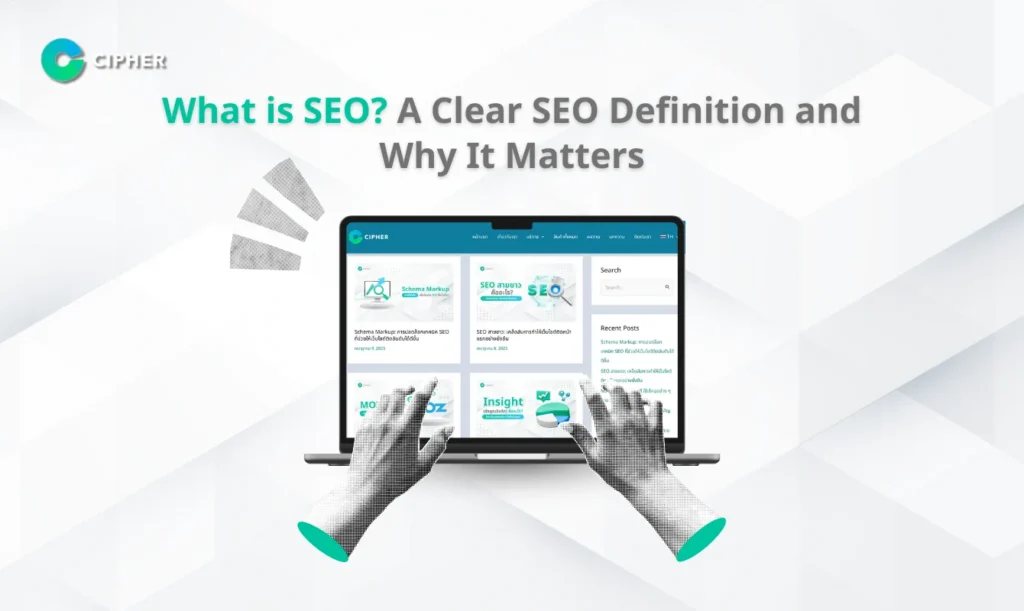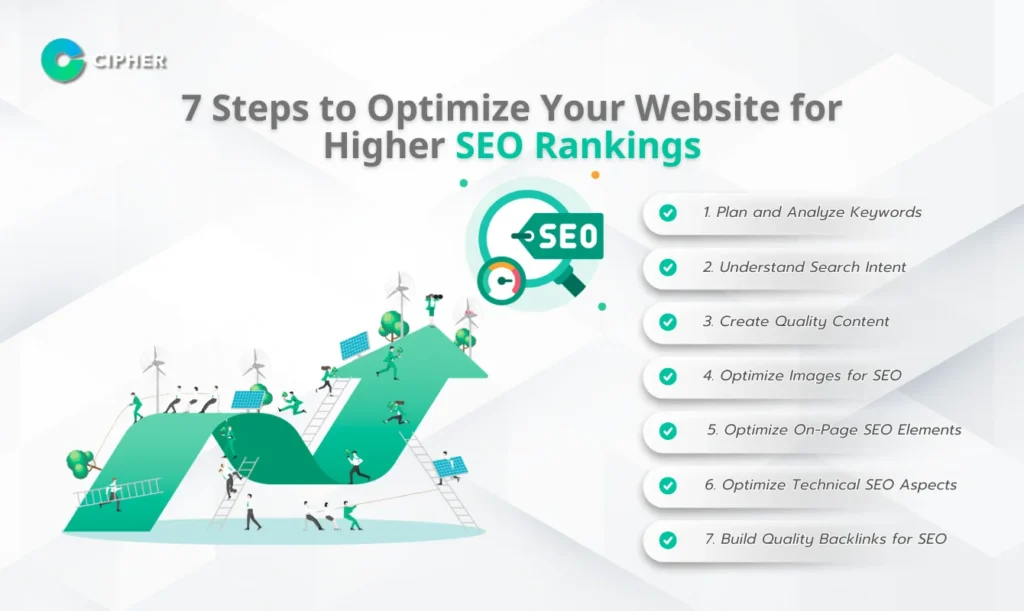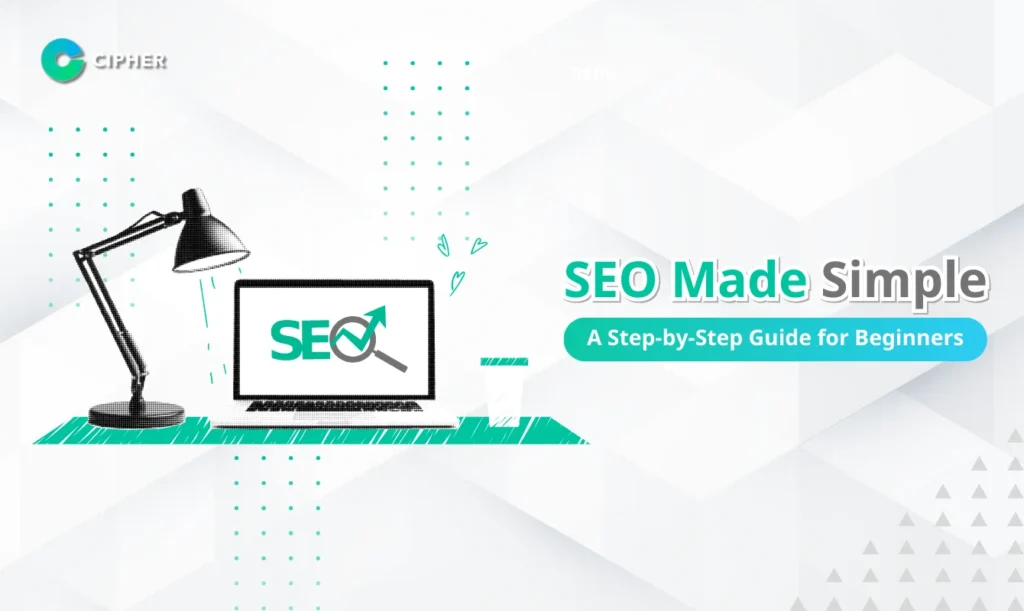If you’re an online business owner or planning to create a new website, you’ve probably heard the term “SEO” frequently. But what exactly is SEO? How can search engine optimization transform your online presence? This comprehensive guide will help you understand SEO principles more deeply so you can apply effective web SEO strategies to your website.
Table of Contents
What is SEO? A Clear SEO Definition and Why It Matters

SEO (Search Engine Optimization) is the process of optimizing your website to be search engine-friendly, particularly for Google, so that your website ranks at the top of search results without paying for online advertising. This SEO definition encompasses all techniques used to improve how search engines view and rank your website.
Every second, Google processes over 99,000 searches (that’s 8.5 billion searches per day!). This represents a golden opportunity for your business to leverage SEO search engine tactics to reach customers who are actively looking for your products or services without you having to find them—they’ll find you instead.
Studies show that over 95% of internet users only click on websites appearing on the first page of Google results. Websites in the first position receive 32% of clicks, the second position gets 16%, and the third position gets 10%. This demonstrates how important implementing proper SEO optimizare techniques is for achieving top rankings.
Moreover, people trust organic search results more than paid advertisements. About 70-80% of users prefer clicking on naturally ranking websites rather than advertisements, making web SEO an invaluable long-term investment.
SEO vs. SEM: Understanding the Differences
In the world of online marketing, you may have frequently heard the terms SEO and SEM. How do these two aspects of search engine marketing differ?
SEO is optimizing your website to rank in organic search results without paying for advertising, focusing on sustainable growth through search engine optimization.
SEM (Search Engine Marketing) is marketing through search engines, which includes both SEO and buying advertisements through Google Ads (PPC – Pay Per Click).
Key differences between SEO and SEM:
| Comparison | SEO | SEM (Google Ads) |
|---|---|---|
| Cost | Requires time and effort, but no cost per click | Pay-per-click: You pay every time someone clicks your adk) |
| Visible Results | Takes time to see results (3–6 months on average) | Immediate results after launching the campaign |
| Sustainability | Sustainable – continues driving traffic even without ongoing cost | Stops delivering traffic as soon as the budget runs out |
| Credibility | Highly trusted by users (not seen as an ad) | May be perceived as an ad, which can reduce click-through rate |
How Search Engines Work: The Foundation of SEO
Before understanding SEO techniques, we need to know how Google and other search engines work. The SEO search engine relationship consists of 3 main steps:
- Crawling: Google sends bots (called Googlebots or Spiders) to explore websites worldwide, collecting data and analyzing what the websites are about and which keywords they relate to.
- Indexing: After collecting data, Google organizes this information in a database (Index), categorizing which websites relate to which topics.
- Serving & Ranking: When someone searches for information, Google searches its database and displays the best results to users, ranked according to relevance and website quality.
Google uses multiple factors to determine which websites should rank at the top, and SEO principles must consider these factors:
- Relevance to search terms
- Unique and valuable content
- Good website structure and functionality
- Website credibility
- References (Backlinks) from other websites
Key Components of Effective Search Engine Optimization
1. On-Page SEO
On-Page SEO involves optimizing content and structure within your website to be friendly to both Google and readers, including:
- Appropriate keyword usage in titles, content, and URLs
- Setting page titles (Title Tags) and page descriptions (Meta Descriptions)
- Structuring content with H1, H2, H3 systematically
- Adding internal links connecting to other pages on your website
- Using images with descriptions (Alt Text)
- Creating quality content that addresses readers’ needs
2. Off-Page SEO
Off-Page SEO builds credibility for your website from external factors, primarily related to:
- Building quality backlinks from trustworthy websites
- Getting shares and mentions on social media
- Guest posting on other websites
- Creating valuable content that people want to share
- Digital PR to build brand recognition
3. Technical SEO
Technical SEO involves technical adjustments to make your website operate efficiently, including:
- Making your website load quickly (Page Speed)
- Ensuring your website is mobile-friendly
- Using HTTPS for security
- Creating XML Sitemaps and Robots.txt
- Fixing Crawl Errors
- Optimizing URL structure for search engine optimization
- Improving Core Web Vitals efficiency
All three components must work together in balance and cannot be separated if you want your SEO search engine strategy to be effective in the long term.
7 Steps to Optimize Your Website for Higher SEO Rankings

1. Plan and Analyze Keywords
Good SEO starts with choosing appropriate keywords. The foundation of web SEO relies on keywords that should:
- Be relevant to your business
- Have sufficient search volume
- Have competition you can realistically compete with
- Align with customer needs
To find keywords for your SEO optimizare strategy, you can use tools such as:
- Google Keyword Planner
- Ahrefs
- SEMrush
- Ubersuggest
After obtaining keywords, you should group and prioritize them to determine which content to create first as part of your search engine optimization plan.
2. Understand Search Intent
Search Intent refers to the “intention” or “purpose” of users searching for specific keywords, which can be divided into 4 main types:
- Informational Intent: Looking for information, e.g., “What is SEO definition”
- Navigational Intent: Wanting to go to a specific website, e.g., “Facebook login”
- Commercial Intent: Comparing options before purchasing, e.g., “iPhone 15 vs Samsung S24”
- Transactional Intent: Ready to buy products, e.g., “Buy iPhone 15 cheap price”
Understanding Search Intent helps you create content that better meets user needs, which is essential for effective web SEO.
3. Create Quality Content
Quality content is the heart of good SEO principles, which should:
- Address what readers want to know about search engine optimization
- Contain accurate, complete, and updated information
- Be written in easy-to-understand language
- Have an easy-to-read format (short paragraphs, subheadings, bullet points)
- Include images or videos to increase interest
- Be of appropriate length, neither too short nor too long
- Provide more useful information than other websites
Additionally, you should place keywords in important positions such as:
- In the main heading (H1)
- In the URL
- In the first paragraph of content
- In subheadings (H2, H3)
- In image descriptions (Alt Text)
But be careful not to stuff too many SEO keywords (Keyword Stuffing) as this will negatively affect your ranking later.
4. Optimize Images for SEO
Images are important for making content interesting, but if not properly optimized, they can harm your SEO search engine performance. You should:
- Name image files meaningfully (e.g., “seo-definition-2025.jpg” instead of “IMG_1234.jpg”)
- Compress file sizes to load faster while maintaining good quality
- Add image descriptions (Alt Text) containing keywords that accurately describe the image
- Use images truly relevant to your content, not just for decoration
5. Optimize On-Page SEO Elements
Besides content, there are other elements on the page that need optimization for SEO:
- Title Tag: Should be about 50-60 characters long, with the main keyword at the beginning, and compelling enough for people to click
- Meta Description: Should be about 150-160 characters, describing the content of that page interestingly, and including the main SEO keyword
- URL: Should be short, concise, and contain the main keyword, e.g., example.com/what-is-seo
- Heading Structure: Use H1 for main headings and H2, H3 for subheadings in order
- Internal Links: Link to other relevant pages on your website
- Outbound Links: Link to credible external information sources
6. Optimize Technical SEO Aspects
Technical SEO is often overlooked but very important in the search engine optimization process. For effective web SEO, you should:
- Make your website load quickly (preferably under 3 seconds)
- Make your website mobile-friendly
- Use HTTPS for security
- Create an XML Sitemap and submit it to Google
- Check and fix Broken Links
- Set up Robots.txt to tell Google which pages should or shouldn’t be crawled
- Check for Duplicate Content and fix it with Canonical Tags
7. Build Quality Backlinks for SEO
Backlinks are links from other websites pointing to your website, which are like “votes” telling Google that your website is valuable and credible. Effective ways to build backlinks for SEO optimizare include:
- Creating high-quality content that people want to share
- Guest posting on websites related to your business
- Creating infographics or useful information for others to use
- Contacting websites with content related to your business
- Submitting your website to quality directories
Avoid buying spammy backlinks or creating Link Farms, as these can harm your website in the long run, which goes against proper search engine optimization principles.
How to Measure SEO Performance
SEO isn’t just about implementation; it requires continuous measurement and improvement. Key metrics to track include:
- Keyword Rankings – What position your website ranks for target SEO keywords
- Organic Traffic – Number of visitors coming from organic searches
- CTR (Click-Through Rate) – The rate at which people click when your website appears in search results
- Bounce Rate – The rate at which visitors leave your website without any activity
- Dwell Time – How long visitors stay on your website
- Conversion Rate – The rate at which visitors convert to customers
- Number of Backlinks – The quantity and quality of backlinks pointing to your website
Tools for measuring web SEO performance include:
- Google Analytics
- Google Search Console
- Ahrefs
- SEMrush
- Moz
Common SEO Mistakes to Avoid
While search engine optimization has many benefits, there are common mistakes that many people unknowingly make, which can harm their websites:
- Writing content without SEO keywords – making it difficult for Google to understand what your website is about
- Keyword stuffing – making content unnatural to read and potentially being penalized by Google
- Copying content from other websites (Duplicate Content) – Google doesn’t like duplicate content and won’t rank it
- Using article spinning software – resulting in unnatural and low-quality content
- Creating spammy backlinks – can lead to Google penalties
- Using intrusive pop-ups – negatively affects user experience and can lower rankings
- Ignoring mobile-friendliness – Google now uses Mobile-First Indexing for ranking
- Ignoring mobile-friendliness – Google now uses Mobile-First Indexing for ranking
The Future of SEO in the AI Era
AI technology is rapidly changing the SEO landscape. Both Google and other search engines are developing smarter AI systems. Here’s what to prepare for in the future of search engine optimization:
- Content must emphasize quality over quantity – AI can better evaluate content quality
- Voice search will play a larger role – SEO keywords need to be more natural
- E-E-A-T (Experience, Expertise, Authoritativeness, Trustworthiness) – Google is placing more importance on expertise and credibility
- Zero-Click Searches – Google displays answers without users having to click on websites
- AI Search – Intelligent search systems like ChatGPT, Google AI Overview, and Perplexity will play bigger roles in the SEO search engine relationship
SEO Services from CIPHER - Helping Your Business Rank on Google Without Advertising Costs
CIPHER is ready to elevate your website with comprehensive search engine optimization services. With a team of experts with over 10 years of experience, we’ve helped more than 500 clients rank at the top of Google for highly competitive keywords. Our web SEO services include:
Building Your SEO Foundation with Targeted Strategy
Elevating Content to Appeal to Both Readers and Google
Fixing Technical Issues for a Strong, Google-Friendly Website
Building a Quality Backlink Network to Increase Credibility
Real-Time Tracking with Easy-to-Understand Reports
Flexible Packages for Businesses of All Sizes
Whether you’re a small business or a large organization, we have SEO packages suitable for your budget and goals, making search engine optimization accessible for all businesses.
Contact us today at 081-633-3636 for a free consultation and quote!





